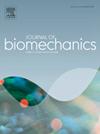IF 2.4
3区 医学
Q3 BIOPHYSICS
引用次数: 0
摘要
负重强行军是作战人员的一项典型任务。不幸的是,在这些任务中受伤的发生率很高,最常见的受伤机制是滑倒、绊倒或摔倒。鉴于个体在内侧平面的稳定性较差,我们试图了解负重、性别和任务完成情况对强行军时内侧稳定性参数的影响。24 名(12 名女性,12 名男性)新兵年龄的成年人(18-35 岁)完成了空载和负重 55% 的强行军试验。计算了质心位置(zB)、方向(Δ zB)、步宽(w)和躯干冲量(JTrunk)的平均值和标准偏差。对每个参数的时间序列进行了去趋势波动分析和直接控制分析。只有 JTrunk 的平均值和变异性在不同条件下发生了变化,随着负荷的增加而增加(p = 0.006; p < 0.001)。负荷对 zB 和 Δ zB 控制没有影响,前者受到最小控制,后者受到严格控制。增加负荷会降低对 w 和 JTrunk 的控制(p = 0.004),但后者仍然受到严格控制。性别没有影响,但与完成负载试验的个体相比,未能完成负载试验的个体的 JTrunk 更大(p = 0.038)。加载时对 JTrunk 的持续严格调节表明,他们试图减少大的幅度偏差。无法完成任务的人的 JTrunk 较大,这可能表明限制冲力的躯干肌肉力量/耐力有限。或者,这些人可能使用了不适合限制躯干运动的协调模式。因此,JTrunk 可能是一个重要的评估参数,可用于识别风险较大的个体。本文章由计算机程序翻译,如有差异,请以英文原文为准。
Effects of load carriage on lateral stepping regulation during forced-marching
Forced-marching with heavy loads is a typical task for warfighters. Unfortunately, injury incidence is high during these tasks with the most common mechanism of injury being a slip, trip, or fall. Given that individuals are less stable in the mediolateral plane we sought to understand how load carriage, sex and task completion impacts parameters of mediolateral stability during forced-marching. Twenty-four (12F, 12 M) recruit-aged adults (18–35 years) completed trials of forced-marching unloaded and with a load 55 % of bodyweight. Mean and standard deviation of center of mass position (zB), heading ( zB), step-width (w), and trunk impulse (JTrunk) were calculated. Detrended fluctuation analysis and direct control analysis were performed on time-series of each parameter. Only JTrunk mean and variability changed between conditions, increasing with load (p = 0.006; p < 0.001). Load had no effect on zB and zB control with the former being minimally controlled and the latter tightly regulated. The addition of load decreased (p = 0.004) control of w and JTrunk but the latter was still tightly regulated. There were no effects of sex but individuals who failed to complete the loaded trial had greater (p = 0.038) JTrunk compared to those who did. The continued strict regulation of JTrunk when loaded suggests an attempt to reduce large magnitude deviations. Larger JTrunk of individuals unable to complete the task may indicate limited trunk muscle strength/endurance to restrict impulse. Alternatively, these individuals may utilize a coordinative pattern poorly suited for constraining trunk movement. Therefore, JTrunk may represent an important parameter of assessment to identify individuals of greater risk.
求助全文
通过发布文献求助,成功后即可免费获取论文全文。
去求助
来源期刊

Journal of biomechanics
生物-工程:生物医学
CiteScore
5.10
自引率
4.20%
发文量
345
审稿时长
1 months
期刊介绍:
The Journal of Biomechanics publishes reports of original and substantial findings using the principles of mechanics to explore biological problems. Analytical, as well as experimental papers may be submitted, and the journal accepts original articles, surveys and perspective articles (usually by Editorial invitation only), book reviews and letters to the Editor. The criteria for acceptance of manuscripts include excellence, novelty, significance, clarity, conciseness and interest to the readership.
Papers published in the journal may cover a wide range of topics in biomechanics, including, but not limited to:
-Fundamental Topics - Biomechanics of the musculoskeletal, cardiovascular, and respiratory systems, mechanics of hard and soft tissues, biofluid mechanics, mechanics of prostheses and implant-tissue interfaces, mechanics of cells.
-Cardiovascular and Respiratory Biomechanics - Mechanics of blood-flow, air-flow, mechanics of the soft tissues, flow-tissue or flow-prosthesis interactions.
-Cell Biomechanics - Biomechanic analyses of cells, membranes and sub-cellular structures; the relationship of the mechanical environment to cell and tissue response.
-Dental Biomechanics - Design and analysis of dental tissues and prostheses, mechanics of chewing.
-Functional Tissue Engineering - The role of biomechanical factors in engineered tissue replacements and regenerative medicine.
-Injury Biomechanics - Mechanics of impact and trauma, dynamics of man-machine interaction.
-Molecular Biomechanics - Mechanical analyses of biomolecules.
-Orthopedic Biomechanics - Mechanics of fracture and fracture fixation, mechanics of implants and implant fixation, mechanics of bones and joints, wear of natural and artificial joints.
-Rehabilitation Biomechanics - Analyses of gait, mechanics of prosthetics and orthotics.
-Sports Biomechanics - Mechanical analyses of sports performance.
 求助内容:
求助内容: 应助结果提醒方式:
应助结果提醒方式:


